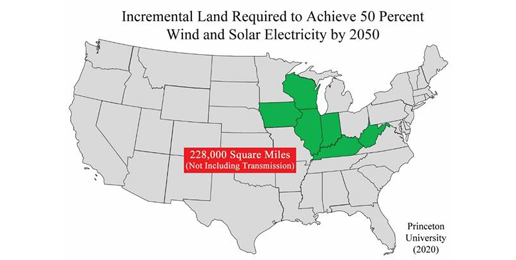
Which is more environmentally friendly — an energy source that uses one unit of land to produce one unit of electricity, or a source that uses 100 units of land to produce one unit of electricity?
The answer should be obvious.
Nevertheless, “green” energy advocates call for a huge expansion of wind, solar and other renewables that use vast amounts of land to replace traditional power plants that use comparatively small amounts of land.
Vaclav Smil, professor emeritus at the University of Manitoba in Canada, extensively analyzed the power density of alternative sources used to generate electricity. He defined power density as the average flow of electricity generated per square meter of horizontal surface (land or sea area).
Estimating power density is complex. Smil included plant area, storage yards, mining sites, agricultural fields, pipelines and transportation, and other associated land and sea areas in his analysis.
Smil’s work allows us to compare the energy density of electricity sources. If we set a nuclear plant to one unit of land required for one unit of electricity output, then a natural gas-powered plant requires about 0.8 units of land to produce one unit of output. A coal-fired plant uses about 1.4 units of land to deliver one unit of power.
But renewable sources require vastly more land. A standalone solar facility requires about 100 units of land to deliver the same average electricity output as a nuclear plant that uses one unit of land.
A wind facility uses about 35 units of land if only the concrete wind tower pads and service roads are counted, but over 800 units of land for the entire area spanned by a typical wind installation.
Production of electricity from biomass has the poorest energy density, requiring over 1,500 units of land to output one unit of electricity.
As a practical example, compare the Ivanpah Solar Electric Generating System in the eastern California desert to the Diablo Canyon Nuclear Plant near Avila Beach, California.
The Ivanpah facility produces about 793 gigawatt hours per year and covers an area of 3,500 acres. The Diablo Canyon facility generates about 16,165 gigawatt hours per year on a surface area of 750 acres. The nuclear plant delivers more than 20 times the average output on about one-fifth of the land, or 100 times the power density of the solar facility.
To approach even 50 percent renewable electricity using primarily wind and solar systems, the land requirements are gigantic.
“Net-Zero America,” a 2020 study published by Princeton University, calls for wind and solar to supply half of U.S. electricity by 2050, up from about 14 percent today. The study estimated that this expansion would require about 228,000 square miles of new land, not including the additional area needed for transmission lines.
That is larger than the combined area of Illinois, Indiana, Iowa, Kentucky, West Virginia and Wisconsin. This area would be more than 100 times as large as the physical footprint of the coal and natural gas power systems that would be replaced.
Taking land for wind and solar can seriously impact the environment.
Standalone solar systems blanket fields and deserts, blocking sunlight and driving out plants and animals. Since 2000, almost 16 million trees have been cut down in Scotland to make way for wind turbines, a total of more than 1,700 trees felled per day. This environmental devastation will increase the longer net-zero goals are pursued.
Wind and solar require vast amounts of land to generate the electricity required by modern society. Without fears about human-caused climate change, these systems would be considered environmentally damaging.
Net-zero plans for 2050, powered by wind and solar, will encounter obstacles with transmission, zoning, local opposition and just plain space that are probably impossible to overcome.
This article was originally published by The Western Journal.




















